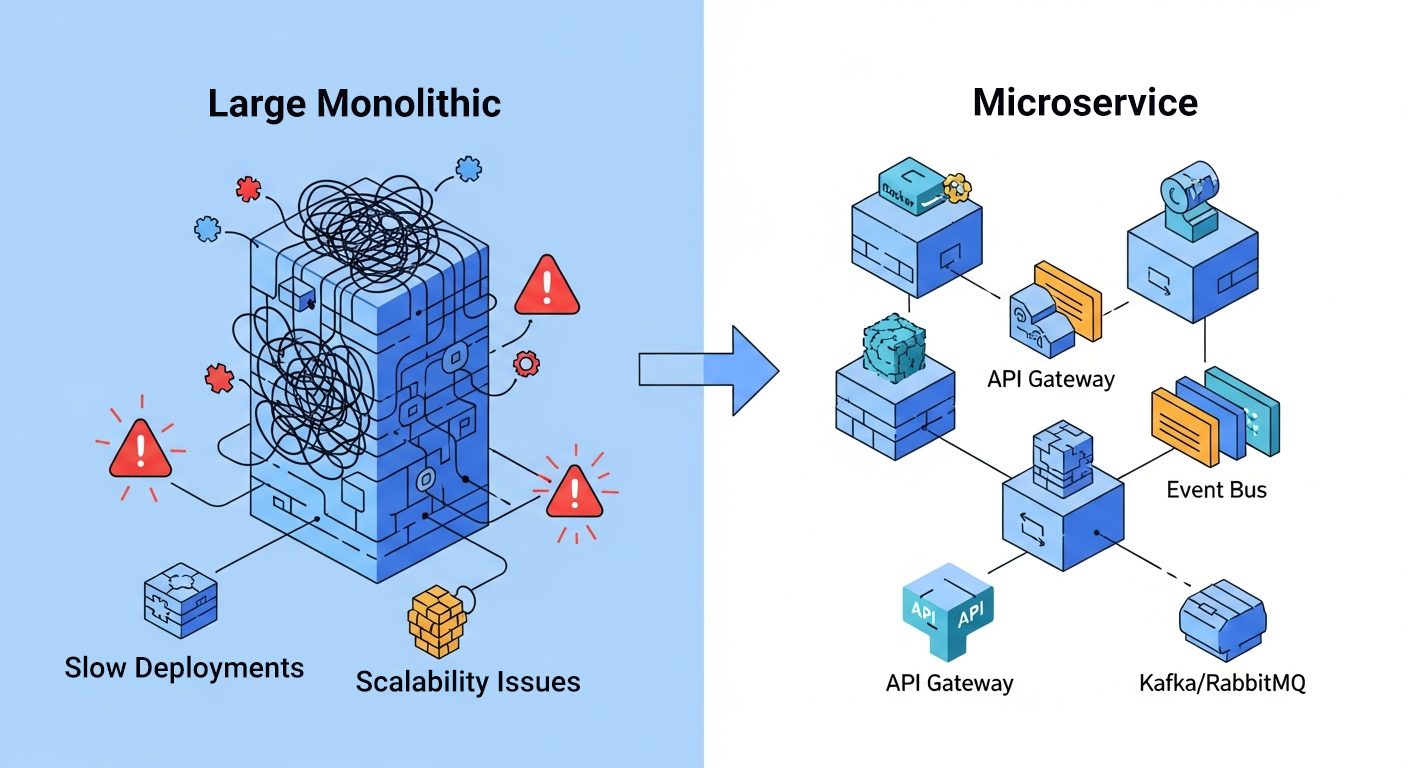Client
A rapidly growing digital platform serving millions of users. Their monolithic application was becoming:
-
Hard to scale
-
Slow to deploy
-
Risky to modify
-
Difficult for multiple teams to work on simultaneously
To continue growing, they needed to modernize their architecture.
Project Overview
We migrated the client’s monolithic codebase to a fully modular microservices architecture, enabling:
-
Independent deployments
-
Faster development cycles
-
Horizontal scaling per service
-
Domain-driven design (DDD)
-
Event-driven communication between services
Key components included:
-
Domain decomposition
-
API gateway setup
-
Kafka/RabbitMQ messaging
-
Containerization
-
Observability tools
-
CI/CD pipelines for each microservice
Key Challenges
1. A Large, Complex Monolith
tightly coupled modules
shared database schema
unpredictable side effects
2. Hard-To-Scale Codebase
Scaling the entire monolith for one module was expensive.
3. Slow Deployments
A single bug in one module required redeploying the entire system.
4. Long Development Bottlenecks
Teams were blocking each other due to shared code and dependencies.
5. Zero Downtime Required During Migration
Platform had to remain live 24/7.
Our Solution
1. Domain Decomposition (DDD Approach)
We conducted in-depth analysis of:
-
Business domains
-
Subdomains
-
Bounded contexts
-
Responsibilities and data ownership
Then identified logical microservices such as:
-
User Service
-
Auth Service
-
Orders Service
-
Inventory Service
-
Notification Service
-
Billing Service
Each service got:
-
Its own codebase
-
Its own database
-
Well-defined boundaries
-
Independent CI/CD pipeline
2. API Gateway Setup
We deployed an API Gateway to:
-
Route requests to correct microservice
-
Enforce authentication and authorization
-
Handle rate limiting
-
Unify monitoring and logging
-
Support versioning
Tools used (based on client preference):
-
Kong / NGINX Gateway / AWS API Gateway / Traefik
This provided a single entry point for all clients.
3. Event-Driven Communication Using Kafka or RabbitMQ
We built:
-
Asynchronous communication
-
Event-based messaging between services
-
Loose coupling via publish/subscribe patterns
Benefits:
-
No service depends on another being “online”
-
Automatic retries
-
High throughput message streaming
-
Works perfectly for:
-
Order events
-
Inventory updates
-
Notifications
-
Activity logs
-
Kafka was used where high throughput was essential;
RabbitMQ was used where message delivery guarantees mattered.
4. Database Decoupling
Moved away from the monolithic schema by:
-
Splitting into service-owned databases
-
Using separate schemas
-
Eliminating direct cross-db joins
Data synchronization handled through events instead of shared DB.
5. Containerization & Orchestration
All new microservices were:
-
Containerized using Docker
-
Deployed to Kubernetes (EKS/GKE/AKS) or Docker Swarm
-
Equipped with auto-scaling rules
-
Monitored via Prometheus/Grafana
This ensured resilience and easy scaling.
6. Independent CI/CD Pipelines
Each microservice got:
-
Its own repository
-
Its own build pipeline
-
Automated tests
-
Blue-green or canary deployments
-
Zero-downtime rollouts
This allowed teams to deploy multiple times per day safely.
7. Observability & Monitoring
We implemented:
-
Centralized logging (ELK/EFK stack)
-
Distributed tracing (Jaeger/Zipkin)
-
Metrics dashboards
-
Alerts and anomaly detection
This made debugging microservices easy and fast.
Architecture Diagram (Text Version)
Results & Impact
🚀 Independent Deployments
Teams deploy independently without affecting other services.
⚡ Faster Development Velocity
Release cycle improved from once per week → multiple releases per day.
📦 Improved Scalability
Each service scales independently based on demand.
🔍 Better Observability
Traces, logs, and metrics improved troubleshooting by 60%.
🔁 Zero Downtime Migration
Rollout was done gradually with no platform outages.
🔓 Decoupled Architecture
The system is now modular, maintainable, and future-proof.
Conclusion
By transforming the monolithic application into a microservices-based, event-driven architecture, we enabled the client to scale faster, deploy safer, and innovate without architectural bottlenecks.
The platform is now:
-
Highly scalable
-
Easier to maintain
-
Faster to evolve
-
Better for multi-team development
This modernization established a foundation for continued growth and long-term success.

Written by
Oliver Thomas
Oliver Thomas is a passionate developer and tech writer. He crafts innovative solutions and shares insightful tech content with clarity and enthusiasm.





